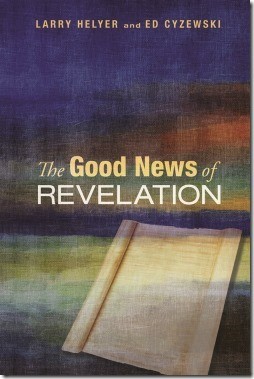
 I have a confession to make: I’ve never read Revelation on my own. In fact, I’ve avoided it because it seemed like a book for Christian conspiracy theorists, numbers obsessives, and end-times enthusiasts — none of which I am. All those apocalyptic images of battles, beasts, horsemen, etc., are so distracting and confusing. Not to mention scary.
I have a confession to make: I’ve never read Revelation on my own. In fact, I’ve avoided it because it seemed like a book for Christian conspiracy theorists, numbers obsessives, and end-times enthusiasts — none of which I am. All those apocalyptic images of battles, beasts, horsemen, etc., are so distracting and confusing. Not to mention scary.
The Good News of Revelation, by Larry Helyer and Ed Czyewski is an antidote to all that.
The authors do not bend themselves backwards to try to make sense of those distracting images for the contemporary reader. They get down to the story basics:
Who were the people this was originally written to?
What was happening in their lives?
What did they need to hear from God?
How did Revelation give them what they needed?
I love drilling down to the core of a story, and I’ve found it so fruitful, in my own spiritual life, to use my imagination in concert with cultural research into what life was like for the people we read about in the Bible — this book was right up my alley.
Helyer and Czyewski begin each section of the book with a short story, each of which is told from the point of view of a different person who was involved in the writing, disseminating, or receiving of this communication from John. These were wonderfully grounding: a real person wrote Revelation, and real people read it and passed it along in spite of real threats to their personal safety. The stories ran the gamut from interesting to truly moving. The final one is my favorite: Lydia, whose husband was dragged away by Roman soldiers, poring over the scroll at night:
“As the rising sun made it easier to read the scroll in front of her, she traced her finger over the small letters once again. One particular line caught her eye every time, ‘He will wipe away every tear.’ She thought of the lonely nights crying by herself and those moments before bedtime where her boys cried out for their father. They didn’t feel safe. She didn’t feel safe. She didn’t know how much more she could take. While the details were vague about God’s new home for his people, she couldn’t stop reading about Jesus wiping away every tear. As good as that sounded for some day, she needed that now. She needed God to step in and deliver her. She needed God to protect and provide for her boys” (p.84).
Phillip’s response to her questions aren’t entirely satisfying, but he sums up the gist of the letter:
“Well, the point of the letter is that God is already victorious. We just don’t see it yet. However, there will come a day when God visibly rules. We don’t know what this New Jerusalem will look like, but the point is that Rome’s days are numbered. While we need to persevere for today, there will come a day when God will reward us with his presence and peace, wiping away every tear.”
All (what I think of as) the weirdness is in service to that basic message, that basic good news.
There is more to Revelation than that, of course. There are specific messages to the seven Asian churches about what they’re doing well and what they need to work on or root out of their congregations. There is prophecy, which the authors connect to the prophetic writing in the Old Testament and define as “inspired speech that appealed to the listeners to repent and to put their complete trust in the Lord;” it can reveal God’s future plans, but doesn’t necessarily give us a “blueprint of the future” (p.8). There is also apocalyptic writing that communicates the fight between good and evil via visions, symbols, and images that would be able to be decoded by those in the know, but opaque to outsiders — and that assured readers/listeners that not only will God win, but God already has.
One of my favorite writing teachers, Lisa Cron, says this about story: “Story, as it turns out, was crucial to our evolution–more so than opposable thumbs. Opposable thumbs let us hang on; story told us what to hang on t0″ (Wired for Story, p.1). In Revelation, John is given a heck of a story to tell the seven churches of Asia, with lots of flashy elements to get them to pay attention and to help them connect this story to stories they’ve heard before, but it is, at root, a story about what and who to hang on to, and encouragement to keep hanging on.
As I read The Good News of Revelation, other stories kept coming to mind: Harry Potter, The Hunger Games, Percy Jackson. Each of them, essentially, contains the message that there is evil, there will be difficultly, you will have to choose your path, evil will come at good over and over again, there will be pain and even death for you and those you love, it matters how you treat everyone, even those “lower” than you, good (and love) will eventually triumph. This is also the message of Revelation.
Please note that Helyer and Cyzewski do not make this connection; that’s on me. You see, I love those stories. Seeing echoes of them in Revelation may give me a way in to a book I’ve avoided. As will having (finally) read all the Old Testament prophets. As will having read The Good News of Revelation. At the glacial rate at which I’m reading through the Bible, I might be at Revelation by the end of the year; I’ll report back then.
The authors are running a Goodreads giveaway, or you can just go ahead and buy it: Amazon | Barnes & Noble.



